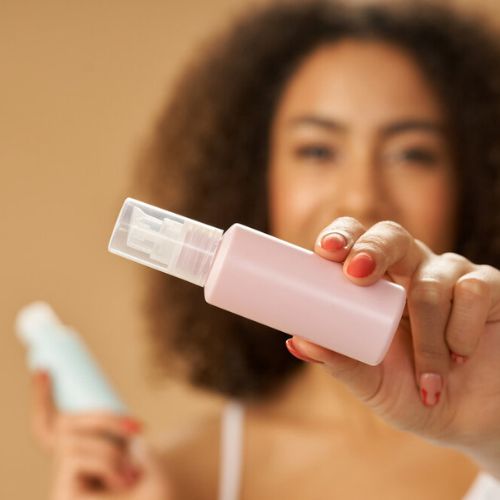Having 4A hair can leave you feeling excluded and frustrated because other hair types get all the attention. One of my sons has 4A hair, so I know a little sumthin’ about this hair type and the difficulty managing it. With that, I’ve created a comprehensive care guide on 4A hair.
Type 4A hair is from the type 4 hair category. It has a coily texture and is characterized by tight curls with a lot of volume. This hair type is prone to dryness, breakage, and frizz. It requires extra nourishment and hydration and even more care when styling.
This guide was designed specifically with type 4A hair in mind. It will cover everything from determining your hair type to finding the best products and hairstyles for your unique hair texture. All the advice you need is right here!
How To Care for 4A Hair

Now that you understand the essentials let’s discuss in detail how to take care of 4A hair. Here are some things you should and shouldn’t do to ensure your hair routine is effective.
Things You Should Do with Type 4A Hair
✔︎ Use a gentle sulfate-free shampoo that won’t strip your hair of its natural oils.
✔︎ Avoid heat-styling tools whenever possible.
✔︎ Apply a deep conditioning treatment.
✔︎ Use leave-in conditioners. This will give your 4A hair silkiness and softness and help protect it against dryness and tangles while delivering much-needed hydration.
✔︎ Use natural hair butter and essential oils to help maintain moisture in your 4A hair type to prevent breakage or damage during styling.
✔︎ You can use hair oils such as grape seed, avocado, jojoba, almond, and argan oils to improve the health of your scalp by complimenting its natural oil. The oils contain essential fatty acids that help to thicken your hair, reduce hair loss, and keep 4A kinky hair healthy.
✔︎ Water is an excellent source of moisture, and adding it to your regular routine can help improve your coils’ health and appearance.
✔︎ Oil your ends to prevent them from splitting and breaking. 4A hair types tend to be drier at the ends, so this is especially important to keep your lubricated.
✔︎ Incorporate a pre-poo oil treatment, which is a great way to preserve and protect your hair during washing and detangling.
✔︎ Don’t forget about your scalp. Taking care of your hair is important, but it is also essential to maintain a healthy scalp. Gently massage your scalp with the shampoo in circular motions to remove dirt and stimulate blood flow to the scalp.
✔︎ Knowing your hair’s porosity is vital to properly handle it. Whether your hair has low or high porosity will dictate which products work better.
✔︎ You can avoid unnecessary frizz and breakage while you sleep! Guard your hair at night using a scarf, bonnet, or satin pillowcase.
✔︎ If you want to avoid split ends, regular trims are key.
✔︎ Lastly, Follow a healthy diet. Nutritious foods with protein, iron, folic acid, B vitamins, dark leafy greens, and antioxidants can all help to improve the health and appearance of 4A hair.
Things You Shouldn’t Do with 4A Hair
✖︎ Do your best to avoid rough handling and over-manipulation of your curls.
✖︎ Avoid tugging or harshly detangling your coils, and use a detangling brush to gently work through the tangles. A wide-toothed comb also works.
✖︎ Avoid hairstyles that add tension. Scalp tension is a major hair concern for 4 hair types. Not only can hair loss or alopecia result from tight styling, but tension can also cause irritation and an itchy scalp.
✖︎ Protective styles, such as braids or locs, should not be kept in for more than two months maximum. Anything longer can put unnecessary stress on the hair follicles and cause damage, leading to permanent hair loss. And don’t neglect moisturizing it!
Challenges Associated with 4A Hair
Here are some challenges you may encounter while caring for type 4A hair, which is unique in its own ways, like all other hair types.
Tangles and single-knot strands: 4A hair is prone to tangling and forming single-knot strands, making styling and detangling challenging.
Dryness: 4A hair is naturally drier than other hair types and can be prone to breakage if it isn’t properly moisturized.
Moisture retention: Those with type 4 hair textures typically have the hardest time retaining moisture because natural oils produced by the scalp have difficulty traveling down curly strands. This often results in dry, brittle ends.
Difficulty styling: 4A hair can be challenging to style due to its curliness, dryness, and tendency to frizz.
Frizz: 4A hair is prone to frizz, especially in humid weather or if it isn’t properly moisturized.
Shrinkage: Because of your tight curl pattern, your hair can shrink to up to half its total length.
Damage: Every bend and kink in each hair strand is a weak point that can easily snap off if you’re not careful. 4A hair is more delicate than other types and tends to break quickly.
What Is Type 4A Hair?

To understand what we mean by type 4A hair, we have to refer to the most common hair typing system created by Andre Walker, who used to be Oprah Winfrey’s hairdresser. There are a number of different systems out there, but this is the most widely accepted and commonly used.
His system is designed to segment hair types based on texture and curl type. There are four different curl types that the system recognizes:
- Type 1: Straight hair
- Type 2: Wavy hair
- Type 3: Curly hair
- Type 4: Kinky hair
The four primary curl types are further categorized into subcategories; A, B, and C. Classifying hair based on these groups provides a more accurate representation of texture and allows you to find proper hair care routines and products to suit your hair needs.
4A hair tends to be easier to manage than 4B or 4C, though it still requires extra attention and care to keep it healthy and hydrated. This hair type typically grows outwards instead of downwards, making it look afro.

Type 4A hair requires a lot of patience and consistency during hair care and styling. You want to handle it with gentleness since it is naturally brittle and breaks easily. Moisturizing this hair type regularly, ensuring the use of quality products, and keeping the scalp clean and healthy is essential.
Heating tools are best kept far from 4A hair because they are likely to only cause more damage, breakage, and hair fall. But if you must use heat on your hair, make heat protectant your holy grail.
Type 4B
Kinky (Z Coil) Hair
Has a less-defined “Z”-shaped pattern.

This hair has a mass of crimpy curls, often seen with compressed and S-shape coils. It is less defined than Type 4A curls and is fluffy like cotton.
Even though curls aren’t well-defined, you can still work to bring out your curl pattern. This type of haircare routine requires much more effort because it’s more prone to breakage and shrinkage (up to 70%).
Type 4C
Kinky (Tight Coil) Hair
Has almost no definition to the coil.

Up close, this pattern has a very tight “o”-shaped pattern, with each strand densely packed and coarse. This curl pattern is frequently mistaken for 4B hair. 4C hair is the most prone to breakage and shrinks the most, often up to 75-80%. It is also the most fragile of all curly hair types.
4C hair is more susceptible to dryness because it’s tightly coiled and requires copious amounts of moisture. When hair is not cared for, it can easily break or snap. This texture requires a lot of TLC and gentle treatment!
Why You Need A Reference Point for Your Curl Type
- Your curl pattern can reveal much about your hair and help you choose the right products and styles to maximize length retention.
- By learning about your hair, you will understand what it does and doesn’t need.
- Understanding your curl type is important because product recommendations vary depending on one’s curl type. It is crucial to determine your hair texture before shopping.
- Although there is no foolproof guide for wavy, curly, or coily hair, this discovery gets you one step closer to healthier and more manageable curls.
Keep these guidelines in mind only as a starting point. They’re meant to help you determine which products work best for your curly hair type. Trial-and-error is the best way to find out what works for your hair.
4A Hairstyles
Looking for 4A hairstyles that are chic and easy to manage? Check out this video.
Remember that not all hairstyles will suit all 4A hair types. You must also consider face shape, hair length, texture, and preference. Here are some ideas:
- Hair twists
- Bantu knots
- Braids
- Freestyle
Accessories for Type 4A Hair
The type of accessories you use for curly hair types are essential to ensuring more damage and breakage do not happen.
These are some accessories that work great for 4A hair:
When you sleep, your hair gets damaged from the rubbing. It leads to hair fall, breakage, and frizz. This is especially bad for 4A hair, which is already so fragile. Silk and satin pillowcases are gentler for your hair. They are even fantastic for your skin and help prevent wrinkles!
The soft and gentle material of microfiber towels is much better for drying your curly hair. They are fast-absorbent and don’t break your hair or cause it to fall like traditional cotton towels.
A hair bonnet is essential for curlies, especially 3 and 4 hair types. Wearing a bonnet while relaxing on the couch or when sleeping protects your hair from being rubbed against. A satin or silk bonnet is best.
These are great if you need to wear a hat. The inside is lined with satin, which is gentle on the hair fibers and doesn’t pull on your hair strands. It also works as a fun styling accessory.
Big claw clips are an excellent accessory for curly, voluminous hair. It can be used to section your hair, style it up or half up, and they don’t pull on your hair because they are large.
These are all-in-one hair ties that are perfect for anyone. They can create several hairstyles, including ponytails and buns. They are perfect for workouts or when you want to add color to your hair.
Best Products for 4A Hair
If you are struggling with 4A hair and never know how to choose the correct product with the widely available range, the list below is an excellent starting point for determining what your hair requires.
Here are some of the best options:
Conditioners
Righteous Roots 2 n 1 Conditioner
Camille Rose Naturals Jansyns Moisture Max Conditioner
Eden BodyWorks Peppermint Tea Tree Conditioner
Mielle Organics Mongongo Hydrating Conditioner
Oyin Handmade Honey Hemp Conditioner
Pattern Beauty Lightweight Conditioner
Pattern Beauty Intensive Conditioner
Carol’s Daughter Coco Creme Curl Quenching Conditioner
SheaMoisture Conditioner for Curly Hair Red Palm Oil and Cocoa Butter with Flaxseed Oil
The Mane Choice Ancient Egyptian Anti-Breakage & Repair Antidote Conditioner
Leave-In Conditioners
Mielle Organics Pomegranate & Honey Leave-In Conditioner
Carol’s Daughter Goddess Strength Leave-In Conditioner with Castor Oil
Shea Moisture Raw Shea Butter Detangler
TPH BY TARAJI Mint Condition Tingling Moisturizing Scalp Leave-in Conditioner
Soultanicals Knot Sauce Coil Detangler
Aunt Jackie’s Knot On My Watch Instant Detangling Therapy
Camille Rose Naturals Latte Define Leave-In Hair Conditioner
Curl Creams
African Pride Moisture Miracle Shea Butter & Flaxseed Oil Curling Cream
Carol’s Daughter, Hair Milk 4-in-1 Combing Creme
Cantu Leave-In Conditioning Repair Cream
Camille Rose Almond Jai Twisting Butter
I AM As Double Butter Rich Daily Moisturizer
Cantu Shea Butter Curl Activator
Mielle Organics Pomegranate & Honey Curl Smoothie
Sheamoisture Curl Stretch Pudding
It’s a 10 Haircare Miracle Coily Curl Cream
Gels
Camille Rose Aloe Whipped Butter Gel
Mielle Organics Honey & Ginger Styling Gel
Pattern Beauty Strong Hold Gel
Curls & Potions- Curling Potion Styling Gel
Curlsmith Curl Defining Styling Soufflé
Mielle Organics Hawaiian Ginger Moisturizing Styling Gel
The Mane Choice Ancient Egyptian Anti-Breakage & Repair 24-Karat Gold Twisting Hair Gel
Aunt Jackie’s Flaxseed Recipes Don’t Shrink Elongating Hair Curling Gel
Deep Conditioners
As I Am Hydration Elation Conditioner
Soultanicals Afrotastic Curl Elastic
Eden Bodyworks Jojoba Monoi Deep Conditioner
Curls Blueberry Bliss Reparative Hair Mask
Curls Dynasty Pumpkin Mint Deep Treatment Masque
Shea Moisture Manuka Honey & Mafura Oil Intensive Hydration Hair Masque
Tips for Using a Deep Conditioner
The best deep conditioners are the ones that directly cater to your personal hair needs. Before you purchase a deep conditioner, analyze your hair’s needs.
Here are some questions to ask yourself:
- Does your hair lack moisture?
- Is your hair damaged from heat or coloring treatments?
- Is it dry and brittle?
The frequency of deep conditioning depends on your hair’s needs rather than adhering to some general rule, as everyone’s hair is unique. By using deep conditioners, we can give our hair back what it’s lost and ensure that it stays strong and healthy.
The weather can majorly affect your hair’s health and condition. It is important to consider your climate when choosing which deep conditioner to use. Additionally, consider your lifestyle and overall health and how that impacts your hair’s health and contributes to dryness.
Emollients and Humectants
Products moisturize, soften, and smooth skin and hair contain emollients. Emollients work by creating a protective barrier on the surface of the skin or hair. This barrier helps to lock in moisture, preventing water loss and keeping your hair hydrated.
Common emollient ingredients include:
- Mineral oil
- Petrolatum
- Shea butter
- Avocado oil
- Olive oils
- Coconut oil
Humectants are chemical compounds in cosmetic ingredients that absorb, bind, and hold water molecules. In other words, they are sealants that seal in moisture and protect your hair from water loss.
Common humectant ingredients include:
- Honey
- Glycerin
- Panthenol (pro-vitamin B5)
- Aloe vera
When choosing a deep conditioner, look for products that contain emollients and humectants like shea butter, coconut oil, glycerin, and aloe vera. These ingredients help to hydrate and nourish your hair, leaving it soft and shiny. If your hair is brittle and dry, you need a product that will hydrate ad moisturize it.
If you have color-treated, highly porous, or damaged hair from heat or other processing, you might need a deep conditioner with protein to strengthen your strands and give them new life. Not everyone’s hair needs protein regularly. Learn your hair’s needs and choose a deep conditioner accordingly.
FAQs
How often should 4A hair be washed?
Some people with 4A hair may need to wash it more frequently, while others may be able to go longer between washes. The best approach is to experiment with different washing schedules, check the oiliness or dryness, and adjust your washing schedule accordingly.
Why is my 4A hair so stiff?
Hair that becomes stiff is dried out or hardened from overuse of styling products. You might have used too many protein-containing products, leading to a build-up of said molecules on your hair’s surface. Cleanse your scalp and hair using a clarifying shampoo to remove excess product.
How often should I moisturize my 4A hair?
4A hair types may need daily or every-other-day moisturizing with oil treatments, hair masks, and deep conditioning if the hair is dehydrated.
What happens if you don’t wash your hair for 3 months?
If you don’t wash your hair for a few months, it may become oily, brittle, matted, or tangled. Your scalp may also develop flaking and dandruff, and the natural oils produced may become rancid.
Summary
Type 4A hair has tight coils, which tends to cause dryness because moisture can’t pass down to the strands. 4A hair is beautiful, healthy, and luscious if cared for properly. Choose the best products and routines for your hair texture and curl pattern.
















